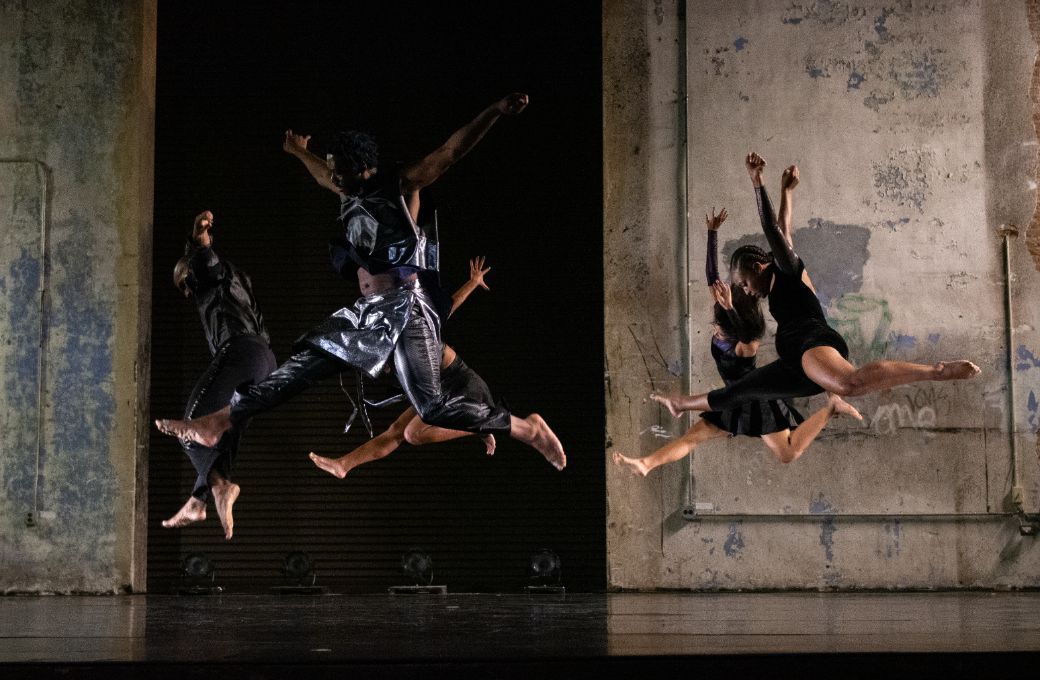At the outset of Kyle Marshall’s monumental Onyx, we hear a scorching guitar riff from Sonny Sharrock overlaid with the sound of a crowd going mad, while dancer Bree Breeden backs reluctantly onto the stage from the wings, as if trying to extricate themself graciously from a crush of fans. In a 1991 interview Sharrock said “I’ve been trying to find a way for the terror and the beauty to live together in one song… the sweetness and the brutality.” The same might be said of Onyx, Marshall’s impressionistic tribute to Black and Brown musicians who birthed rock and roll but whose achievements have been undervalued, appropriated or obliterated.

The piece is driven by a formidable sound collage by Kwami Winfield who has sampled music and speech from music artists such as Little Richard, James Brown, LaVern Baker and Tina Turner, and overlaid radio interference and industrial and futuristic sounds. The sound of Big Mama Thornton growling “You ain’t nothing” over and over on a loop makes a fierce reminder that, while Elvis may have taken it to the top of the charts for a record-breaking 11 weeks, “Hound Dog” is at heart a Black woman’s song of rage at a deadbeat casanova.
To this turbulent score, Marshall and his stunning dancers dance triumph and frustration, and the seductiveness of fame. Their moves are sweeping, swiveling, strutting, sultry, sometimes small-scale and delivered with irony – interspersed with social dances like the Twist and the Pony, and gently fluttering hands that suggest church healing rituals.
At one point, DEATH, the original punk band (yes, before the Ramones), sings of ‘Freakin Out.’ House lights suddenly go up, stage and house are bathed in a harsh light, and we hear a sound like a jackhammer. The dancers shiver, shadowbox, and fall to the ground. The audience is in plain view. We seem to be implicated as music consumers enabling an exploitative system. Darkness descends again on the house, the audience is again invisible, and the dancers are back on their feet. Tina Turner mourns an absent lover (“I can’t stand the rain”) and the dancers make glorious spiraling shapes with their arms as they exit.
Pictorially rich and sonically stunning, with a historical theme of cultural theft that spans more than a century, Onyx could easily have been an evening-length work. But this program offers two other compelling dances with radically different soundtracks. Alice is a meditative solo to three short, shimmering pieces by Alice Coltrane on piano and harp, the music channelled with increasing intensity and magnificent control by Bree Breeden. Uplifted gaze, fluid arms and pillowy leaps respond to the spirituality evoked in the pieces written during Coltrane’s ashram years, after the death of her husband John. But at the end, lighting designer Itohan Edoloyi draws attention to the abyss by turning on stark neon lights to frame a crumpled metal backdrop. Staring at it, I thought I saw the image of a giant contorted face in a scream.
Ruin is a hypnotic group piece set in an eerie soundscape orchestrated live by the dancers. Creative director Edo Tastic has outfitted them in jagged-edged tunics painted in shades of blood, earth and ochre. He pulled their hair into tight little mounds around their head, and slashed their temples with bright red paint. Sound designer Cal Fish set loops of coiled copper wire around the stage which held pre-recorded tracks of sounds (my ears detected insects, birds, running water, bells, gongs, people in crowds.) These sounds are activated by electromagnetic equipment housed in buckets that the dancers carry into or swing over the wire loops on the floor. Fish fine tunes the sounds from a soundboard downstage. It’s not necessary to understand any of this to fall under the spell of Ruin, but it helps to appreciate the dancers' virtuosity.
What appears to be a day in the life of a nomadic tribe starts with buckets in hand: going to collect sounds, or in search of precious water. To navigate desert terrain apparently requires fluid swirling movements like liquid mercury, and silent springy jumps. Heavy stomping may ward off predatory animals. In a gorgeous signature move, the dancers hop onto one leg with the other foot drawn up to the knee then shoot that foot out behind them while dipping the torso forward – like shooting an arrow with a drawstring bow. There is much unison dancing in the piece, some of it to percussive sounds that the dancers make by stomping and drumming their chests. Movement phrases often end abruptly in a freeze or a soft unfolding of an arm, as if to mark the spot of some new discovery. The sound of rain intensifies as nightfall approaches, the future of this tribe uncertain.


